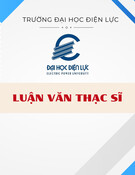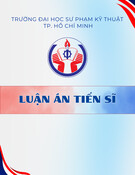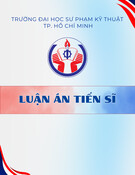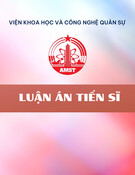MINISTRY OF EDUCATION VIETNAM ACADEMY OF
AND TRAINING
SCIENCE AND TECHNOLOGY GRADUATE UNIVERSITY OF SCIENCE AND TECHNOLOGY
-----------------------------
Phan Thi Tra My
OPTIMIZATION OF ENERGY FLOW IN
PORT-CONTROLLED HAMILTONIAN SYSTEM
Major: Mechanical engineering
Code: 9520101
SUMMARY OF MECHANICAL ENGINEERING
DOCTORAL THESIS
Ha Noi – 2020
The work was completed at: Graduate University of Science and Technology - Vietnam Academy of Science and Technology.
Science instructor 1: Assoc.Prof. Dr. La Duc Viet
Science instructor 2: Dr. Luu Xuan Hung
Reviewer 1: ...
Reviewer 2: ...
Reviewer 3:….
The thesis will be defended in the Academy-level doctoral thesis evaluation council, meeting at the Graduate University of Science and Technology - Vietnam Academy of Science and Technology at… o'clock .. ', date… month ... in 2020
The thesis can be found at:
- Library of Graduate University of Science and Technology
- National Library of Vietnam
1
INTRODUCTION
1.The urgency of the thesis
Oscillation control technologies are becoming the base technology
for the development of constructions, mechanical systems, with
applications from medium-sized systems such as vehicles, robots,
rotors, to large systems such as skycrapers, bridges, tunnels ...
In terms of energy, vibration control can be divided into three types:
passive control, semi-active control and active control. The properly
essence of the oscillation control problem is to optimize the flow of
oscillating energy drawn from the controlled system. This is a
research direction with many applications. The selection of thesis in
the direction of "Optimizing the energy flow in controlling
mechanical system oscillation" aims to initially approach this
method.
2. The objectives of the thesis
The main objective of the thesis is to provide general methods to
control oscillation based on measurement of energy flow, namely:
- Find the optimal solution for passive control systems based on
energy flows
- Propose the semi-active control algorithms to control the energy
flow
3. The main research content of the thesis
Research objects:
- The vibration isolation of a single degree of freedom system
- The quarter car model with two degrees of freedom
- Tuned mass damper (TMD) for single degrees of freedom system
- TMD for multiple degrees of freedom system
2
Scope of the research: passive and semi-active control for specific
objects mentioned above, in case of harmonic excitation.
Research methods
- Use power flow criteria: solve min-max problems, find optimal
parameters in the passive control case or control algorithms in semi-
active case.
- Time-shifting technique, harmonic balancing method: used to find
the performance index of the designed controller and the lower
bound solution, thereby correcting the control law
- Numerical simulation by Matlab software: used to evaluate the
effectiveness of analytical solutions and control algorithms.
Layout of the thesis: The thesis consists of 4 chapters, introduction
and conclusion
Chapter 1. Overview of research issues. This chapter presents an
overview of oscillation control methods and basic energy flow
formulas.
Chapter 2. Controlling the power flow in the isolator.
Chapter 3. Controlling the power flow in the quarter car model
Chapter 4. Controlling the power flow in the tuned mass damper.
General conclusions. Present the main results obtained in the thesis,
new points and next major research directions.
3
CHAPTER 1. OVERVIEW
This chapter classifies the control methods based on energy and
limits the scope of the methods used in the thesis. The basic systems
of the PCH system (Port Controlled Hamilton System) were
introduced to describe the dynamics systems and the energy flow
equations in these systems.
1.1. Vibration control
The control methods base on energy include passive, active and
semi-active control. In fact, the control of variation depends on the
nature, characteristics and also on the cost (due to the active control
with high cost) of each specific project. This thesis studies only
passive and semi-active control.
1.2. Energy flow analysis
The variable studied in energy flow analysis is a combination of
effects due to force, velocity, and their product, power, ie the rate of
energy change. This combination plays a role as a unique parameter
to describe the dynamics and responses of a system, including and
reflecting fully the equilibrium and motion of the system. Therefore
overcome limitations in the study of separate displacement response
and force response.
1.3. PCH (Port- Controlled Hamiltonian Systems)
The classic Hamilton system can be rewritten in the following form
(1.5)
where z is the system state, H is the Hamiltonian function, u is the
input of the system, G is the input distribution matrix, J satisfying
4
is the lossless interaction structure matrix, R satisfying
, is the dissipation structure matrix, y is the output of the
system. The equation system (1.9) called the PCH system was first
introduced by Maschke and Van der Schaft (1999).
The equation "energy flow" has the form
(1.9)
where the left side is the change of Hamiltonian (which is usually
chosen as a total of kinetic and potential energy). The first term in
the right side is the "energy flow" or “power flow” into the system
characterized by power variables u and y. The second term is the
energy flow dissipated through the matrix R.
1.4. Issues of the thesis
1.4.1. Research situation
The domestic research on vibration control has been carried out a lot,
but most studies are based on the classical approach, not considering
the energy flow aspect. The studies of semi-active control were also
initially studied domestically and applied to brake, clutch and force
feedback devices. However, the control laws are still based on the
classic approach, and at the same time, the law of semi-active control
has not been shown.
1.4.2. The problem of the thesis
The thesis focuses on the analytical studies of optimizing parameters
in passive control or proposing semi active control algorithms based
on the energy flow applied to three specific types of vibration control
systems, with increasing degrees of freedom, from simple to
complex.
5
CHAPTER 2. CONTROLLING THE ENERGY FLOW
IN THE ISOLATOR
This chapter considers the problem of vibration control using the
single degree of fredom isolator. After making the energy flow
formulas in the isolator, the thesis will study the effect of the
parameters of the isolator in the passive case with the assumption of
harmonic motion. In the case of semi-active, the thesis proposes an
on / off control algorithm based on the energy flow and corrects this
algorithm based on the optimal control algorithm.
2.1. Concept of vibration isolator
Vibration isolation, essentially, involves inserting an elastic (or
isolation) component between the vibration mass and the source of
vibration to reduce the system dynamic response. Vibration isolation
can be achieved by passive, semi-active and active modes.
2.2. The energy flow in the vibration isolator
Consider the details of an isolator as shown in Figure 2.5.
Figure 2.5: Vibration isolator model
The dimensionless motion equation has the form PCH:
(2.9)
6
In which
(2.10)
Energy flow into the system:
(2.11)
where
is the damping ratio of the isolator
The energy flow (2.11) consists of two components: the energy
flowing from the base into the spring and the energy
flowing from the damper into the isolated mass .
Because damping is a controlled quantity, we consider direct control
of the P2 energy flow component.
2.3. Effect of the isolator parameters
In the case of hamonic external foundation , is
the dimensionless frequency, is the dimensionless time,
applying the analytical methods, we obtain the energy flow P2
consisting of three terms, two terms oscillating with the frequency
2 (called the oscillating energy flow) and the third term constant
(called the average energy flow).
7
(2.23)
Solving the min-max optimization problem for the average energy
flow , we obtain the optimal value:
(2.37)
is the damping ratio for the isolator to take energy out of the system
the most in the case of passive control.
2.4. On off damping controller based on the energy flow
Considering the semi-active control problem, the damping ratio can
vary between h and l. Based on the energy flow formula (2.11),
consider the control law:
(2.38)
If P2<0 means that the damper is taking power out of the system, the
damping is set to the on value of h to activate the damper.
Conversely, if the dampers are putting energy into the system (P2>0),
set the damping value at l to limit the damper operation. We
perform numerical simulations in 3 cases of excitation frequency:
resonance, fixed point and above fixed point, corresponding to non-
8
dimensional frequencies of 1, and 2 to illustrate the effectiveness
of the semi active control algorithm.
In three cases, the on off damping controller is the best. In the case of
fixed points (figure 2.7), large and small damping create oscillation
with a non-dimensional amplitude equal to 1. However, on off
controller create smaller oscillation. This means that the on off
damping has overcome the inherent limitations of passive damping.
Fig 2.6: Amplitude case =1 Fig 2.7: Amplitude case =
Fig 2.8: Amplitude case =2
2.5. Adjustment based on controlling the optimal on off damping
9
In this section, the thesis presents an on off control law for the best
effect in class. Control rules based on the energy flow (2.38) (which
is a separate case in the class of control laws considered) can be
adjusted according to the optimal control law presented.
Using time-shifting technique and harmonic balance method, in case
of harmonic oscillation, find the lower bound:
(2.56)
is the smallest amplitude response in the class of all the optimal
control rules whose time shifting depends on the product of any two
harmonic functions.
The thesis proposes an improved form of controller (2.38) based on
the lower bound response (2.56):
(2.57)
Where is a adjustment parameter, changed so that the controller
(2.57) is tracing to (2.56).
10
Table 2.1. The amplitude of x varies with the adjustment parameter
0 (not 0.5 1 = - improved)
Amplitude of 1 0.7 0.6 0.7 1 x/r0
the lower bound 0.6 JL/r0 at =
The results in Table 2.1 show that the adjustment value = 0.5 gives
slightly better efficiency than the case without correction = 0.
2.6. Conclusion of chapter 2
In the case of passive control, with the assumption of foundation in
harmonic form, the thesis shows the optimal damping ratio value of
the isolator
In the case of semi-active control, the thesis has proposed an on off
controller based on the energy flow and perform numerical
simulations in three cases of excitation frequency: resonance, fixed
point and above fixed point, corresponding to the dimensionless
frequency equal to 1, and 2. The calculated results all conclude
that the on / off resistance is much more effective than the large
passive damping and small passive damping.
In order to improve the efficiency, the thesis will export the
controller by a parameter based on the lower bound response
(which is the response of the optimal on / off control law). The
results show that the calibration parameter is about 0.5 for the
response at the frequency of the fixed point (ω = ) to reach the
theoretical optimal value. The results of this chapter are presented in
the articles [T1], [T2], [T7]
11
CHAPTER 3. CONTROLLING ENERGY FLOW
IN A QUARTER CAR MODEL
Similar to the procedure in the previous chapter, this chapter
considers the oscillation control problem for a typical 2-degree-order
mechanical system, which is a quarter car model.
3.1. Concept of car suspension
Conventional suspension is made up of 3 main parts: elastic
component, shock-absorbers and a set of mechanical components
remaining. The quarter car model describes the interaction between
the suspension, the tire and the body at ¼ the vehicle. Instead of
using classic criteria for comfort and road-holding, it is possible to
use an energy flow criteria to unify the design of both problems.
3.2. Power flow formulations
Consider the quarter car model in Figure 3.3.
Fig 3.3. the quarter car model
Similar to the previous chapter, through the Hamilton function, it is
possible to write motion equations in the form of PCH. In the case of
the road profile is presented in the harmonic forrm, using the
analytical methods, the average energy flow as:
(3.24)
12
3.3. Effect of shock absorber damping
Solve the min-max optimization problem for the average energy
power
We have the optimal solution of damping:
(3.33)
Consider a numerical example of a motorcycle as follows:
Ms=117kg, Mt=30kg, K=26000 N/m, Kt=200000 N/m, x0=1cm.
Figure 3.4: Average energy flow with different absorber’s damping
The results show that both too large and too small damping increas
the flow of energy into the system.
3.4. On off damping controller based on the energy flow
Considering the semi-active control problem with the aim of the
vehicle's comfort, the energy flow into the system has the form:
(3.41)
The proposed controller based on the energy flow formula (3.40) has
the form:
(3.42)
13
If the absorber is taking power out of the body mass, the damping is
set to bh to enable the absorber. Conversely, set the damping value at
bl to limit the damping operation. With the data given above, in
addition consider bl = 700Ns / m, bh = 3000Ns / m. The calculation
results clearly show the effectiveness of the on / off controller based
on the energy flow when compared to the case of passive control.
Figure 3.7: Frequency response of vibration amplitude of body mass
3.5. Adjustment based on controlling the optimal on off damping
Similar to section 2.5, this section presents an improved form of
controller (3.41) based on the lower bound. However, the difference
here is that this controller for quarter car model is first found by us
and published it in the article [T2].
In case of harmonic external force:
(3.49)
Using time-shifting techniques and harmonic balancing methods,
performance index was found
(3.60)
With
14
(3.62)
And lower bound amplitude
(3.66)
Where A is the system matrix, D is the location matrix of a single on
/ off damper with on off damping b, Hf is the input location vector, bh
and bl respectively are the on-value and off-value, vector r expresses
the location of the target states.
Considering the adjusment controller of (3.42) has the form:
(3.67)
Where is a improved coefficient found by solving the
(3.68) minimum problem:
(3.69) Với:
Where i is the tracking frequency, JA is the performance index of
the designed controller and JL is the lower bound (3.66).
15
Figure 3.8: Frequency response of vibration amplitude of body mass
The results in Figure 3.8 show that the curve produced by the
improved controller nearly coincides with that of the lower bound
controller.
3.6. Conclusion of chapter 3
In the case of passive vibration control, the thesis has shown the
optimal analytic solution of the shock absorbers based on the energy
flow cretaria.
In the case of semi-proactive, the thesis has proposed an on off
controller based on the energy flow. Through numerical simulations
in specific cases, the calculation results clearly show the efficiency
of the controller when compared with the case of passive control.
To consider this real adjustment, the thesis has found an optimal on
off controller in the controller class with the time shifting depending
on the product of the 2 harmonic functions, applied to a quarter car
model. From the response of the lower bound amplitude of the
optimal controller, the thesis found the scalar coefficient and shown
the frequency response that closely matches the lower bound curve.
The chapter results are presented in the articles [T2], [T4], [T6].
16
CHAPTER 4. CONTROLLING ENERGY FLOW
IN TUNED MASS DAMPER
This chapter studies the oscillation control problem for the model of
mass dampers of one and many degrees of freedom. In the semi-
active case, this chapter proposes several versions of the on / off
control controller based on the energy flow and improved this
controller.
4.1. Concept of tuned mass dampers
Tuned mass dampers (TMDs) are one (or more) of the auxiliary mass
installed into the main structure via connections, typically springs
and dampers. TMD systems with the on / off damping do not have an
accurate solution. Most of the studies in the literature use numerical
methods. The approximate analytic solutions on many degrees of
degrees of freedom are hardly seen and this is the research goal of
this chapter.
4.2. Power flow formulations
Consider a set of TMD as shown in Figure 4.10.
Figure 4.10: Model of TMD installation system
With:
(4.6)
The maximum value of the energy flow is the sum of the amplitudes
of oscillating energy with the average energy. The external
dimensionless maximum energy flow Pm from the outside into the
17
whole system (including main system and TMD system) has the
form:
(4.24)
The non-dimensional external maximum energy flow Pm from
outside plus the TMD word transmitted to the main system has the
following form:
(4.29)
4.3. Effect of parameters of tuned mass damper
Solve the min-max optimization problem for maximum energy flow
in 2 cases (4.24) or (4.29). The optimal solutions opt
and opt found using this numerical method are compared to the Den
Hartog solution:
(4.30)
The comparison results show that in the case of energy flow into the
system, the optimal solution is very close to that of Den Hartog.
18
However, in the case of an external power flow into the main system,
the optimal parameters differ significantly from those of Den Hartog.
This shows that the solution of Den Hartog is not large enough to
limit the flow of energy into the main system.
Figure 4.11: Maximum energy Figure 4.13: Maximum energy flowing into the system with flowing into the main system =5% with =5%
4.4. On and off damping controller based on the energy flow
Figure 4.15: The MDOF system attached with dynamic vibration
absober
Denote the location of the single harmonic loading by the vector s,
the loccation of the target mass by the vector r, and the location of
the TMD by the vector v. The symbols ma, ka and ca are respectively
the mass, the stiffness, and the on / off damping of TMD.
4.4.1. Controller for maximal flow of energy to TMD - version 1
19
In this controller’s version, it is aimed to maximize the vibrational
energy of the absorber to attract the energy from the MDOF main
system. The power-driven controller (version 1) is proposed as
follows:
(4.41)
Meaning that if the power flow is into the TMD, the small damping
value cl is used to activate the TMD. On the contrary, with the
undesirable trend, the large damping value ch is only used to restrict
TMD activities.
4.4.2. Controller of minimum energy flow into the system -
version 2
In this controller’s version, it is aimed to minimize the
energy injecting to the whole system. The power-driven
controller as follows:
(4.46)
This means that if energy flows into the system, a large damping
value ch is used to limit TMD activity. In contrast, the small damping
value cl is used to activate TMD.
4.5. Adjustment based on the optimal on off daming
Similar to sections 2.5 and 3.5, in this section, the thesis proposes the
lower bound response generated by the optimal on off controller.
This is a new result of the thesis and was presented in [T3]. The
exitation is assumed as harmonic form , the
20
undamped transfer function HAB between two certain vectors a and b
and is defined as:
(4.56)
Using time-shifting technique, harmonic balance method, through
many steps of transformation, we can find the performance index:
(4.70)
With
(4.61)
The lower bound JL is obtained by minimizing the function (4.70)
with the single parameter ts. Based on this lower bound solution, the
power driven controller version 1 (4.41) is improved as:
(4.71)
And the power driven controller version 2 (4.46) is improved as:
(4.72)
21
where is a constant parameter. The parameters can be optimized
to make the controller trace as close as posible to the optimal bound
controller.
4.6. Example of numerical calculations
Figure 4.16: The 4 DOF system attached with on / off damping
absorber
Table 4.1. Numerical values of the main system’s parameters
5 6 7 1 2 3 4 index
k (N/m) 30,000 30,000 20,000 50,000 20,000 30,000 45,000
4 10 4 8 m (kg)
1 1 1 1 F (N)
Naturel
frequency 8.196 12.250 22.621 33.279
(Hz)
Table 4.2. Passive absorber’s parameters of TMD, tuned to first
mode
TMD attached to ma=0.5kg mass #1 mass #2 mass #3 mass #4
1301.1 1225.3 1315.2 1375.9 ka (N/m)
3.7 7.0 3.0 2.3 Passive damping cp
(Ns/m)
22
Table 4.3. The ratio of on damping and off damping to passive
damping in the case study
Passive ch=cl=cp
On off ch=2cp, cl=0.2cp
Table 4.4: Parameters of power driven controller
TMD attached to
mass mass mass mass
#1 #2 #3 #4
7.64; 7.22; 7.82; 7.94; Traced frequency 8.12; 7.82; 8.12; 8.18; (Hz) 8.54 8.78 8.48 8.42
parameter 0.1 0.1 0.1 0.0 (controller version 1)
parameter 0.4 0.2 0.4 0.6 (controller version 2)
Figure 4.17: Frequency Figure 4.18: Frequency response when TMD attaches response when TMD attaches to mass # 1; to mass #2;
23
Figure 4.20: Frequency Figure 4.19: Frequency
response when TMD attaches response when TMD attaches
to mass # 4; to mass #3;
Some observations are drawn:
- Both controller versions work well and give better results than
passive control.
- Calculating at the frequency of 3 inflection points greatly reduces
parameters optimization.
4.7. Conclusion of chapter 4
In the passive case, the optimal parameters based on the flow of
energy from outside to the system and the flow of energy from
outside plus the flow of energy from TMD into the main system have
been found by numerical methods and compared to the Den Hartog
solution, which applies to 1 DOF system.
In the case of semi-active, the thesis has proposed two versions of
the on off damping controller based on two different energy flow
criteritions, applicable to multi degrees of freedom system attached
to TMD. In order to improve these two versions better, the thesis
created a lower bound response, numerical simulation calculations
were performed to clarify the flexibility in selecting the energy flow
criteria to control. The results of chapter 4 are presented in the
articles [T3] and [T5].
24
CONCLUSION
The use of energy flow criteria remains an open direction in the
country. The use of the norm is a scalar quantity that gives flexibility
in the application of this energy flow method. The thesis initially
gives basic energy flow formulas and applies to some specific
models.
The new results of the thesis applied to oscillator isolators, a quarter
car models and tuned mass dampers, include:
1. The energy flow criteria has been used to optimize the parameters
of passive controlled systems
2. Proposal of semi-active controller based on energy flow
3. Has found the optimal on off damping controller in the class of the
on off damping controller based on the product of 2 harmonic
functions.
4. The semi-active controller has been improved based on the energy
flow through the lower bound response generated by the optimal on /
off controller.
Further research directions
The objective of the thesis is to optimize the energy flow out of the
system to be controlled. On the other hand, oscillations can be useful
and need to be amplified for use. One of the prime examples is
harvesters, which store kinetic energy from vibrations around the
system. Although the two problems of absorption or amplification
have different goals, the nature of the problem is actually to optimize
the energy flow from the place where the oscillation is harmful to
where the vibration is useful. This shows that this research direction
can be expanded and developed to many new applications.
LIST OF AUTHOR’S WORKS [T1]. Viet Duc La, My Phan Thi Tra , Optimization of two-tuning- knob single-sensor strategy for semi-active isolation, Journal of Sound and Vibration, Vol434, pp126-143, 2018 (SCI, Q1) [T2]. La Duc Viet, Phan Thi Tra My, Lower bound of performance index of an on-off damper in a state-space system, Journal of Mechanical Engineering Science, Vol 233, Issue 12, pp 4288-4298, 2019 (SCI) [T3]. La Duc Viet, Phan Thi Tra My, Theoretical Upper and Lower Bounds of the Performance of an On-Off Damping Dynamic Vibration Absorber Attached to a Multi-Degree-of-Freedom System, Journal of Vibration and Acoustics, 141 (3), 034504 (Jan 31, 2019) (SCIE) [T4] Phan Thị Trà My, Lã Đức Việt, Sử dụng chỉ tiêu dòng năng lượng để tối ưu hóa bộ giảm xóc trong mô hình một phần tư ô tô, Kỷ yếu hội nghị KHCN toàn quốc về cơ khí - động lực, 13/10/ 2016, ISBN: 978-604-95-0042-8, Tập 3, tr 29-33, 2016 [T5] Lã Đức Việt, Phan Thị Trà My, Phân tích ảnh hưởng của các tham số bộ giảm chấn khối lượng lên dòng năng lượng, Kỷ yếu Hội nghị Khoa học toàn quốc lần thứ 2 về Cơ kỹ thuật và Tự động hóa, tr 91-95, 2016 [T6] L.D.Viet, P.T.T.My, Optimization of suspension in a quarter car model using power flow criteria, Proceeding of The Fourth International Conference on Engineering Mechanics and Automation (ICEMA4),pp 192-196, 2017 [T7] L.D.Việt, P.T.T.My, N.B.Nghị, Nghiên cứu thuật toán điều khiển bộ cách ly dao động bán chủ động sử dụng dòng năng lượng, Tuyển tập công trình khoa học Hội nghị Cơ học toàn quốc lần thứ X, tr 644-650, 2017


























